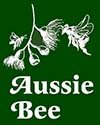A NEW NAME FOR OUR TRIGONA STINGLESS BEES: TETRAGONULA
Aussie Bee > Trigona name changed to Tetragonula
IT'S OFFICIAL: For instance, This name change does NOT affect any of the species in the Austroplebeia genus. So the names of species such as Austroplebeia australis remain unchanged. |
Over twenty years ago, American bee expert, Professor Charles Michener, proposed a classification for the world's stingless bees that was largely followed in Australia. In this classification, the old genus Trigona was a massive one. It included over 100 species from America (from Mexico right down to Argentina), Australia, New Guinea, Indonesia, and westwards to India.
However, DNA studies in 2007 showed that the Trigona bees in our region were sufficiently different from other stingless bees worldwide to deserve their own names.
Importantly, though, someone needed to systematically review all the species in the whole genus, in the light of all the research, and draw up a plan to show how the new names should be applied.
This has now been done. A major reference book on stingless bees was published in January 2013 called 'Pot-honey: a legacy of stingless bees.' Professor Michener contributed a chapter to this book in which he outlined a new classification for all the stingless bees, based on current scientific knowledge.
In this new classification, the large genus Trigona was split up into nine smaller genera and our Australian Trigona bees were all placed in a genus called Tetragonula.
So the names of Australia's six Trigona species became:
Tetragonula carbonaria
Tetragonula clypearis
Tetragonula davenporti
Tetragonula hockingsi
Tetragonula mellipes
Tetragonula sapiens

A Tetragonula carbonaria stingless native bee
Genus Tetragonula also includes 30 other stingless bee species that are found in other countries in our region, such as New Guinea, Indonesia, The Philippines, The Solomon Islands, Malaysia, Thailand, Sri Lanka and India.
This genus name, Tetragonula, was first proposed in 1961 by the Brazilian bee expert, Professor JS Moure. It was part of a major alternative classification system, in which Professor Moure divided the Trigona stingless bees into about 20 genera.
The relevant section of Professor Michener's article (Chapter 1: pages 3 - 8) has been included in a free preview of the 'Pot-honey' book that you can see on the Amazon website. Read Professor Michener's article in the free preview. (Click on the 'Look Inside' link above the cover photo of the book, then scroll through to pages 3 to 8). |
So it is time to start using to this new name for our Aussie Bees! We are changing the name Trigona to Tetragonula throughout the Aussie Bee website. We will progressively update the name in all or our articles and publications.
Getting used to a new name is never easy. However, it is great to have a name for our Tetragonula stingless bees that recognises their distinctive characteristics.
Further Reading
Michener CD (1990) Classification of the Apidae (Hymenoptera). The University of Kansas Science Bulletin 54: 75-164
Michener CD (2007) The bees of the world. Second edition. Johns Hopkins University Press, Baltimore
Michener CD (2013) The Meliponini. In: Pot-honey: a legacy of stingless bees. Vit P. Pedro SRM and Roubik D (eds) Springer, New York. Chapter 1, pp 3-18
Moure JS. (1961) A preliminary supra-specific classification of the Old World Meliponine bees (Hymenoptera, Apoidea). Studia Entomologica 4: 181-242
Rasmussen C and Cameron AC (2007) A molecular phylogeny of the Old World stingless bees (Hymenoptera: Apidae: Meliponini) and the non-monophyly of the large genus Trigona. Systematic Entomology 32: 26-39



